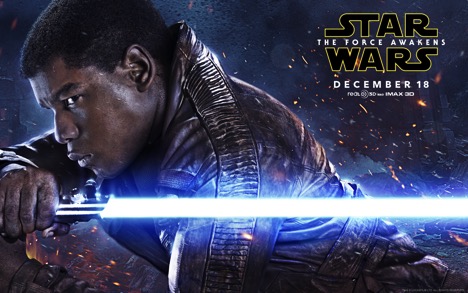A Spoiler-Free Review: Star Wars: The Force Awakens
December 19, 2015
By: Robert Sterner, special for The Broadcaster
When George Lucas sold Lucasfilm and the Star Wars franchise to Disney for $4.04 billion in 2012, there was trepidation in the Star Wars fan base. Was Mickey Mouse going to “do a Disney” and produce a kiddie version of the beloved franchise? Who would direct? What would the story be? Would the original cast return? Would Jar Jar finally die?
The last question touches on the fears of fans. Even George Lucas isn’t above mangling a film or three set in his sci-fantasy universe “a long time ago in a galaxy far, far away.” For fans Star Wars: The Force Awakens is a chance to wash away the bad taste of the unrealized promise of the prequels.
This first installment in a new trilogy washes away any lingering foulness from the prequel with a tsunami of action and nostalgia. This is an epic worthy of the name. New faces to Star Wars begin the action. Daisey Ridley is charming in her portrayal of the naive yet resiliently strong Rey, a scavenger eeking out a living on the desert planet of Jakku. In time she partners with Finn, played by John Boyega. I won’t go into his character for fear of revealing the plot except to say he also does an admirable job providing a mix of comic relief and brash charge-first-think-later action.

However, more important to hard-core fans of the franchise are the returning characters. Harrison Ford, Carrie Fisher, and Mark Hamill reprise their roles as Han Solo, Leia Organa, and Luke Skywalker, respectively. Each actor does a fine job. Ford provides a mix of world-weary soul, veteran bravado, and well-timed one liners. Fisher adds the gravitas of a well-experienced and emotionally scarred grandmother. Hamill? Well, let’s leave that for you to discover.
Managing the conflicting needs of a rabid fan base, a Disney studio that expects a strong return on their $4 billion investment, and a desire to win new fans to the Star Wars banner, J.J. Abrams was an inspired choice to direct. After navigating a successful reboot of another beloved science fiction franchise with directing both 2009’s Star Trek as well as the 2013 sequel Star Trek Into Darkness, Abrams has clearly established his blockbuster credentials. Abrams navigates a tricky middle path. His brand of science fiction is between highbrow concept driven sci-fi like Christopher Nolan’s Interstellar or Stanley Kubrick’s 2001: A Space Odyssey and the lowbrow action driven sci-fi like Michael Bay’s Transformers franchise.
Star Wars: The Force Awakens opened December 17, 2015. The projected total box office could be over to $2 billion before it closes.
Abrams’ casting several relative unknowns to star beside the original cast also hearkened back to George Lucas’ casting choices. In 1977 few knew who Mark Hamill, Carrie Fisher, and Harrison Ford were. The sole bonafide star was Sir Alec Guinness, a great actor, but seemingly past his prime by the late 70’s. Guinness was best known to audiences for 1962’s Lawrence of Arabia and 1958’s Bridge on the River Kwai. Lawrence of Arabia won the Academy Award for Best Picture and Bridge on the River Kwai earned Guinness the Academy Award for Best Actor.
Director J.J. Abrams directs Star Wars: The Force Awakens which opened in over 4,100 theaters, over 3,000 3D theaters, and nearly 400 IMAX screens. The box office returns from the film are expected to top $575 million for the opening weekend alone according to The Guardian.
In The Force Awakens, the supporting cast is excellent as well. The always excellent Max Von Sydow makes a brief, but important appearance early in the film as Lor San Tekka. Returning favorites–C3PO, R2D2, and Chewbacca–make appearances of varying lengths, but enough to cheer fans. Other “new to Star Wars” actors Oscar Isaac, as Poe Dameron, Adam Driver, as Kylo Ren, and Domhnall Gleeson, as General Hux, were all spot-on choices by Abrams.
Without giving away the plot there is enough action–blaster shootouts, stormtroopers stormtrooping, X-Wing and Tie Fighter dogfights, and lightsaber duels–to sate the ardent fans but not overwhelm younger viewers. Fair warning, however, there is one scene, one of violence, that parents may wish to check with the young viewers to see how they handle it. And most importantly there are enough questions to launch a million fan theories and keep us all interested until the next film in the trilogy, the as-yet unnamed Episode VIII, which is slated to hit theaters in May 2017.
There are some flaws, albeit minor ones. Abrams eschewed widespread use of CGI for The Force Awakens opting rather for old school practical effects: real explosions, constructing full scale space ships, and physical sets. According to Making Star Wars the film used only 28 total shots that were completely CGI. That is of 357 total scenes! That said there is one character, a major villain voiced by Andy Serkis, that is completely computer generated, and it shows. And that’s the problem. In a film where the utmost care was taken to “get it right” why did this villain need to be 100% CGI? He’s creepy, eerie, and huge, but, sadly, not as compelling as an actor playing the part would have been.
Another flaw is with Abrams conception of the vastness of space. The distance between two solar systems can be traversed in the snap of your fingers. Usually when characters travel in other films or a director wants to show time passing, the filmmakers will use a montage. A montage is a series of shots edited together to give the viewer the impression that time has passed. Additionally a montage can compress space, that is, distance, or information. It is a standard technique taught to all first-year filmmakers. Abrams, however, abandons it entirely when a thirty second or two minute montage would have give his science fiction universe a sense of scale and grandeur. This is not the first time he’s done this. In both Star Trek films he uses a similar technique, and here too it minimized the scale of the fictional universe. In the Force Awakens (in spoiler free fashion): A map is discovered, and two characters follow it. Rather than show through a montage that time has passed and the the journey was lengthy, Abrams simply and abruptly edits the departure and arrival together. Viola! Everyplace in an Abrams sci-fi universe is very, very close together.
Despite these missteps the evidence is strong that Star Wars is in good hands with Abrams and Disney. The as-yet unnamed second film in the new trilogy will hit screens in May 2017. But there is enough in The Force Awakens to thrill hardcore fans, win over new fans, and hold us all over until the next film Star Wars film. Rogue One: A Star Wars Story, the first of a series of a stand-alone films set in the Star Wars universe, opens December 16, 2016.







